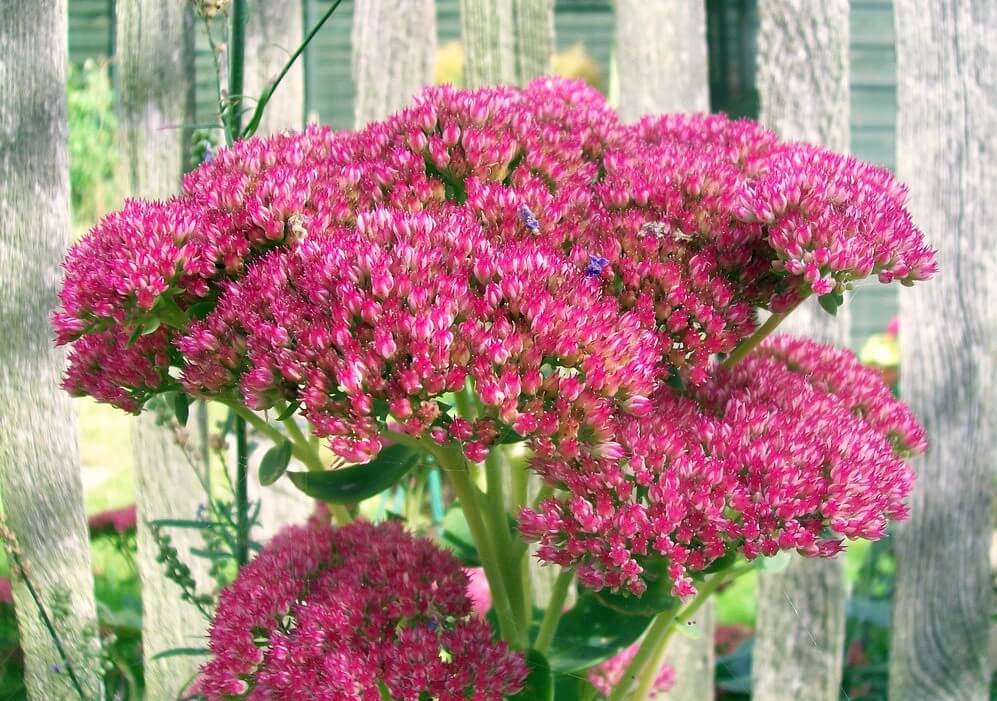Sedum Spectabile, also called Showy Stonecrop or October Daphne, is a popular succulent. It has pretty leaves and blooms in the late season.
This plant is tough and grows well in sunny areas with good soil drainage. It adds beauty to gardens from spring to fall.
Sedum Spectabile is a plant from eastern Asia. It can grow 12-18 inches tall and spread 18-24 inches wide. The thick, fleshy leaves emerge green in spring and often develop pink or red tips in summer heat.
Clusters of pink star-shaped flowers bloom in late summer lasting into fall. The blooms attract pollinators before turning into seed heads that provide winter interest.
Sedum Spectabile can survive in dry and hot conditions with proper care. It needs minimal upkeep and has a long lifespan. This guide helps you grow plants: conditions, planting, care, design, wintering, FAQs answered. To grow healthy Sedum Spectabile, follow these easy recommendations. They will bring joy to your landscape all year.
Key Takeaways:
- Sedum Spectabile, or Showy Stonecrop, is a beautiful and versatile plant for garden landscaping.
- It can survive harsh conditions and is frost-hardy, making it ideal for colder climates.
- Loamy soil with good drainage and direct sunlight are preferred for optimum growth.
- Propagate through stem cuttings or seeds, with stem cuttings being the preferred method.
- Pruning is usually unnecessary, and the plant is resistant to pests like slugs.
Ideal Growing Conditions
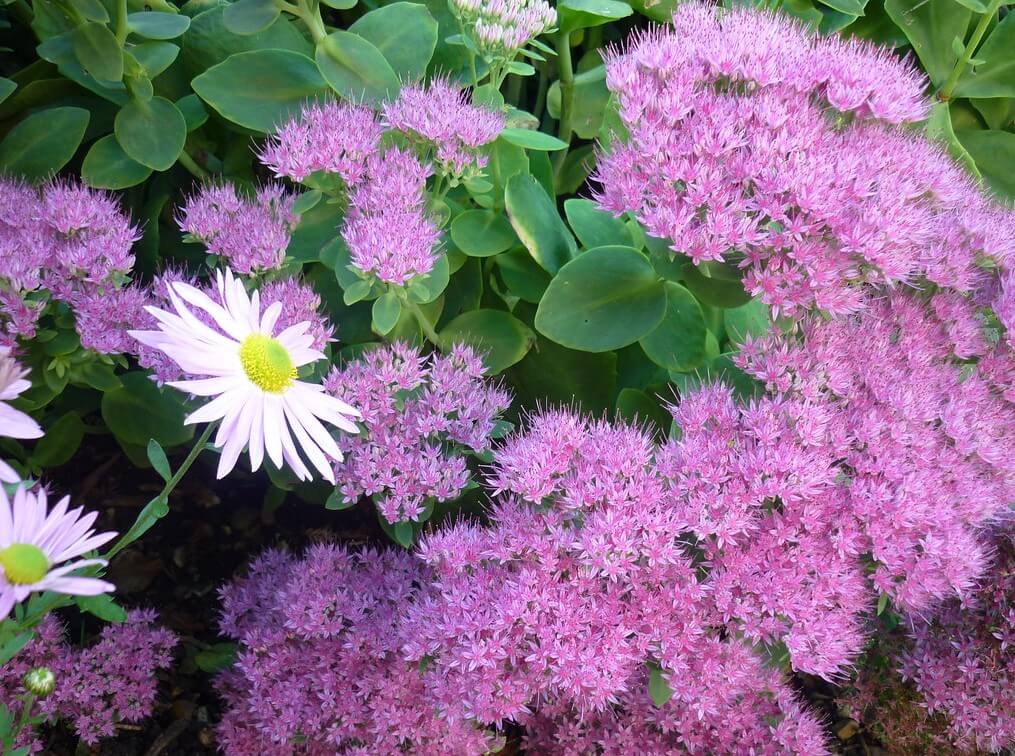
Sedum Spectabile thrives in full sun to partial shade and well-drained soil. This hardy perennial can grow well in a wide range of climates.
Hardiness Zones
Sedum Spectabile can be grown in USDA plant hardiness zones 3 to 9. It can withstand cold winters as low as -40°F in zone 3a and hot summers over 100°F in zone 9b.
Sun Exposure
Full sun is ideal for Sedum Spectabile, with at least 6 hours of direct sunlight per day. Partial shade is also suitable, especially in hot climates. Provide afternoon shade in zone 9 to prevent leaf scorching.
Soil
Sedum Spectabile grows best in sandy, gravelly, or loamy soil with a neutral to slightly alkaline pH of 6.5-7.5. The soil should drain well to prevent rotting of the fleshy roots and crown. Avoid planting in heavy clay or constantly wet soil.
Water
Once the roots are grown, established plants don’t need much water and can tolerate dry conditions. However, consistent moisture is needed for new plantings. Water new plants regularly the first year, allowing the soil to partially dry between waterings. Mature plants only require supplemental water during extreme drought.
Climate Considerations
In colder zones, provide winter mulch to protect the crown from freeze-thaw cycles.
In hot humid climates, allow for good air circulation to prevent fungal diseases.
Overall, Sedum Spectabile is adaptable to a wide range of climates and soil types. Just provide full sun, well-drained soil, and avoid overwatering for best results.
Propagation and Planting
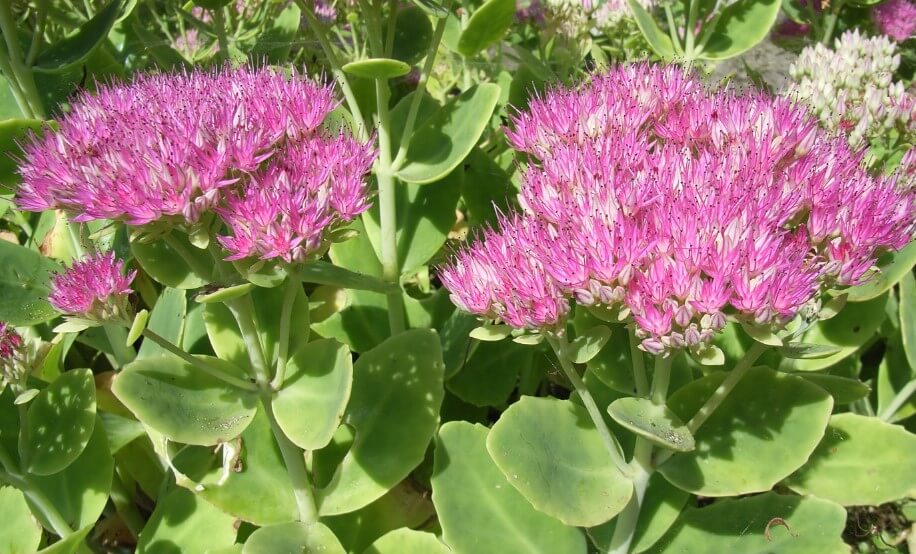
Sedum Spectabile can be easily propagated from seed, cuttings, or division. Spring is the best time to propagate and plant new Sedum Spectabile.
Propagation
Seeds – Sow seeds indoors 6-8 weeks before the last frost. Barely cover the seeds with soil. Keep the soil moist and in temperatures between 60-70°F. Thin seedlings once true leaves appear. Harden off before transplanting outdoors after the danger of frost has passed.
Cuttings – Take 3-6 inch tip cuttings in spring or summer. Remove lower leaves and dip cut end in rooting hormone. Stick cuttings in well-draining potting mix. Keep soil moist and humid. Cuttings root in 3-6 weeks and can be transplanted outdoors after hardening off.
Division – Divide established clumps when dormant in early spring. Use a sharp knife or spade to separate sections with roots attached. Replant divisions immediately.
Planting
Plant in full sun to partial shade with well-drained soil.
Space plants 12-18 inches apart.
Dig a hole twice as wide and deep as the root ball. Set the plant at the same level it was growing in the nursery pot.
Backfill the hole and water thoroughly after planting.
Add a thin layer of mulch around plants to help retain moisture.
Care and Maintenance
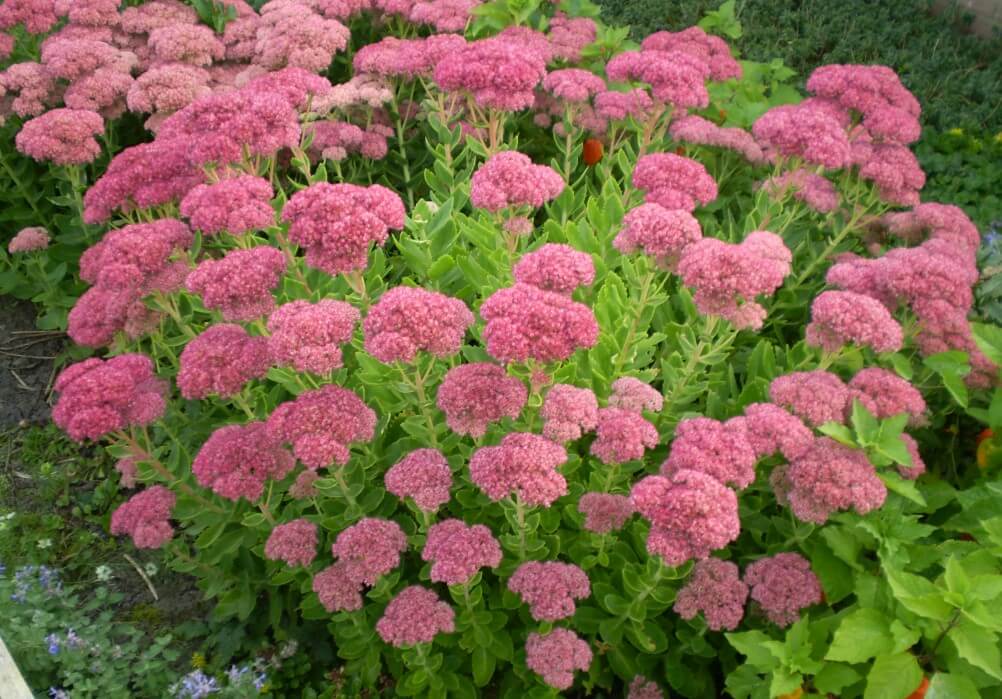
Sedum Spectabile is relatively easy to care for with minimal requirements. Follow these tips for best results:
Fertilizing
Fertilize in early spring with a balanced organic fertilizer or slow-release granular fertilizer.
Top dress annually with compost or apply a liquid fertilizer monthly during the growing season.
Avoid high nitrogen fertilizers that produce lush growth prone to flopping over.
Pruning and Deadheading
Prune off any dead or damaged foliage in early spring.
Remove spent flower heads after blooming to encourage reblooming. Cut back to a leaf node.
Shear off half the plant height in late fall to keep growth compact.
Do you have Euphorbia Characias? If so your can make them happy and flourish by read these tips and trick!
Pest and Disease Problems
Watch for aphids, spider mites, scale, and mealybugs. Control with horticultural oil or insecticidal soap.
Prevent fungal issues like powdery mildew and rust with good air circulation.
Remove diseased foliage promptly to prevent spreading. Avoid overhead watering.
Winter Care and Protection
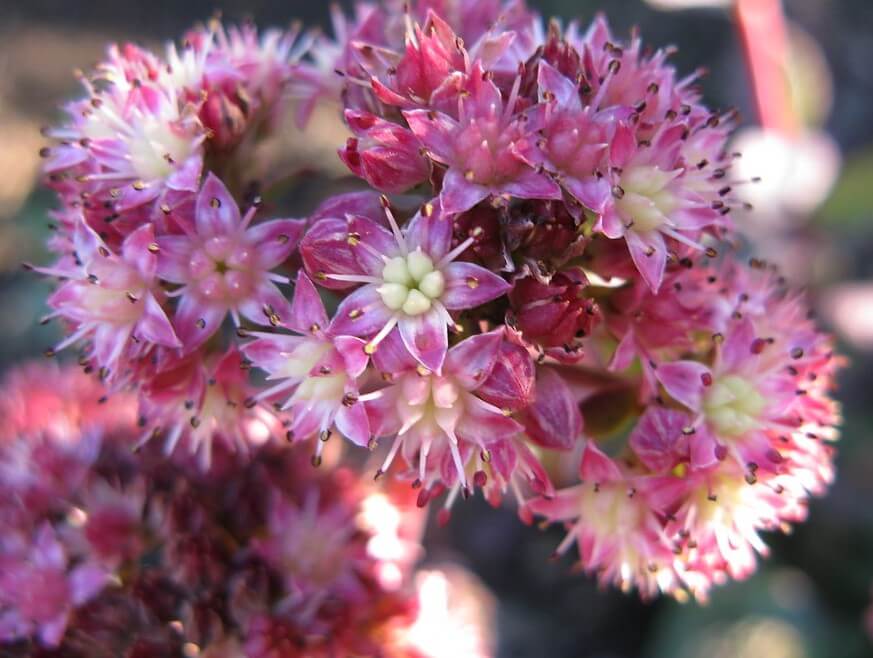
Cut plants back to the ground after hard frost for winter protection.
Apply winter mulch after the ground freezes in cold climates.
Avoid mulch touching the crown which can cause rotting.
Dividing Mature Clumps
Divide congested clumps every 3-5 years in early spring.
Replant the healthiest, outer divisions and discard the center.
Water new divisions regularly until established.
Popular Sedum Spectabile Varieties
There are many lovely varieties of Sedum Spectabile to choose from. The most common include:
‘Brilliant’ – This variety has bright pink blooms that hold their color well. It grows 18-24 inches tall with a spread of 18 inches. ‘Brilliant’ blooms in early fall.
‘Autumn Joy’ – The most popular variety, this sedum grows 18-24 inches tall and wide. Dense clusters of pink flowers deepen to coppery-rust red in fall. Very sturdy and reliable.
‘Autumn Fire’ – A darker pink flowered form of ‘Autumn Joy’ with thicker stems and foliage. Grows 24 inches tall and wide with blooms that turn deep red. Longer blooming.
‘Neon’ – Vibrant reddish-pink blooms on 16 inch tall plants. Foliage is blue-green. Blooms mid to late fall.
‘Matrona’ – Taller variety at 36 inches high. Pale pink flowers age to copper. Sturdy stems support the large flower heads.
‘Purple Emperor’ – Unique dark purple-red flowers on 24 inch plants. Blooms late summer to fall.
There are also many variegated varieties like ‘Frosty Morn’, ‘Lime Zinger’, and ‘Mediovariegatum’ that add unique color and texture to the garden. Dwarf varieties like ‘Xenox’ and ‘Sea Stars’ work nicely in containers or rock gardens.
When selecting a variety, consider the flower color, bloom time, height, and overall form you want. Upright types like ‘Autumn Joy’ work well in perennial borders while low growers make excellent groundcovers.
Design and Companion Planting
Sedum Spectabile is very versatile and can be used in many areas of the landscape.
Landscape Uses
Perennial borders
Rock gardens
Container gardens
Pollinator gardens
Cut flowers
Sedum Spectabile works well in both formal and informal garden designs. The upright varieties provide structure while the spreading types act as groundcovers.
Companion Plants
Grasses like Muhlenbergia capillaris, Panicum virgatum, and Schizachyrium scoparium provide contrasting texture and movement.
Late blooming perennials like Aster, Solidago, and Helianthus complement the fall flowers.
Spring bulbs like tulips, daffodils, and crocus provide early season interest before sedums emerge.
Shrubs like Hydrangea quercifolia and evergreens like Juniperus conferta offer backdrop planting.
Annuals like zinnias, marigolds, and cosmos add bright pops of color in summer before the sedums bloom.
Design Tips
Mass several plants together for best visual impact.
Use taller varieties as thriller plants in container designs.
Plant short varieties along walkways and edges.
Include multiple hues for season-long color.
Allow some seed heads to remain for winter interest.
Sedum Spectabile partners well with many plants. Combine it with other perennials, grasses, bulbs, and shrubs to highlight its late season blooms.
Overwintering and Winter Hardiness
Sedum Spectabile is cold hardy to USDA zones 3-9, but some preparation is still needed for winter. Follow these tips to help sedums successfully overwinter:
Preparing for Winter
Stop fertilizing 6-8 weeks before first frost to avoid stimulating new growth.
Prune plants by half in late fall to keep growth compact going into winter.
Water thoroughly before ground freezes to prevent desiccation. Continue watering during dry winters if possible.
Add a winter mulch like straw or evergreen boughs after several hard frosts.
Expected Dieback
Foliage often dies back after hard frost. This is normal.
Cut back any remaining foliage to the ground once it turns brown.
Protect the crown from damage during frequent freeze-thaw cycles.
Winter Protection Strategies
In very cold climates, cover plants with burlap or frost blankets.
Avoid plastic touching the foliage which can cause freeze damage.
Add extra mulch around the base in zone 3.
Prevent heavy snow from breaking stems by supporting with stakes or small cages.
With proper care, Sedum Spectabile readily overwinters in most regions. Simply give the plant good soil, enough water, and shield it from harsh weather conditions.
FAQ
Propagation
What is the best method to propagate Sedum Spectabile?
Sedum Spectabile is easily propagated from cuttings or division in spring or early summer. Taking 3-6 inch tip cuttings and rooting in potting mix works well. Dividing established clumps is another simple method for propagation.
When is the best time to sow Sedum Spectabile seeds?
Direct sow seeds outdoors in fall. Or for spring planting, cold stratify seeds for 4-6 weeks prior to starting indoors 6-8 weeks before last frost.
Transplanting
How do I transplant Sedum Spectabile?
Carefully dig up and divide clumps in early spring. Replant divisions 12-18 inches apart in well-draining soil. Water thoroughly after transplanting and provide shade for 1-2 weeks until established.
Pests and Diseases
What pests affect Sedum Spectabile?
Watch for aphids, spider mites, scale, and mealybugs. Prevent fungal issues like powdery mildew and rust with good air flow. Promptly remove diseased foliage.
Blooming
When does Sedum Spectabile bloom?
Most varieties bloom late summer into fall. Bloom time ranges from July for early bloomers to October for late blooming varieties. Flowers last 3-6 weeks.
Varieties
What are some good Sedum Spectabile varieties?
Popular varieties include ‘Brilliant’, ‘Autumn Joy’, ‘Autumn Fire’, ‘Neon’, and ‘Matrona’. Choose upright types for borders or low growers for groundcovers. Select colors like pink, red, or purple.
Overwintering
How do I prepare Sedum Spectabile for winter?
Cut plants back to the ground after frost. Add winter mulch after ground freezes. Avoid mulch touching the crown. Provide extra mulch in zone 3.
Conclusion
Sedum Spectabile is an easy to grow perennial succulent that thrives in full sun and well-drained soil. Provide supplemental water for new plantings and during drought. Fertilize lightly in spring. Divide congested clumps every few years.
With proper care, Sedum Spectabile will provide lasting color and texture in the garden from summer into fall.
To get more tips, check out online resources from universities and trusted gardening sites. Connect with local Sedum Spectabile growers to learn what varieties perform best in your area.

